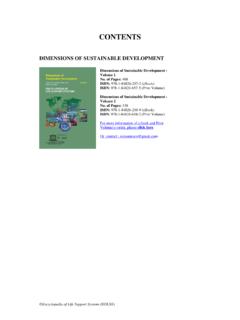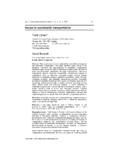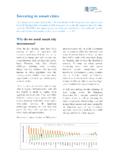Transcription of Guidelines on urban and peri-urban forestry
1 178. 178. FAO forestry PAPER. Guidelines on urban and Guidelines on urban and peri-urban forestry peri-urban forestry Although cities occupy only 2 percent of the planet's surface, their inhabitants use 75 percent of its natural resources; by 2050, 70 percent of the global population will live in cities and towns. Sustainable urban development is crucial, therefore, for ensuring the quality of life of the world's people. Forests and trees in cities , if properly managed, can make Guidelines on urban and peri-urban forestry important contributions to the planning, design and management of sustainable, resilient urban landscapes.
2 They can help make cities more pleasant, attractive and healthy places in which to live, as well as safer, wealthier and more diverse. A few years ago, FAO initiated a collaborative process to develop voluntary Guidelines aimed at optimizing the contributions of forests and trees to sustainable urban development. Scientists, practitioners and public administrators from cities worldwide were brought together to discuss the elements and key challenges of urban forestry , and a smaller team of experts was assembled to distil this vast knowledge. This document is the ultimate result of that process.
3 Intended for a global audience comprising urban decision-makers, civil servants, policy advisors and other stakeholders, it will assist in the development of urban and peri-urban forests that help meet the present and future needs of cities for forest products and ecosystem services. These Guidelines will also help increase community awareness of the contributions that forests and trees can make to improving quality of life, and of their essential role in global sustainability. ISBN 978-92-5-109442-6 ISSN 1999-2882. ISSN 1999-2882. FAO. forestry . 9 7 8 9 2 5 1 0 9 4 4 2 6 PAPER.
4 FAO. I6210E/1 178. Cover photo: flickr/Rom Guidelines on urban and FAO. forestry . PAPER. peri-urban forestry 178. BY. FABIO SALBITANO. SIMONE BORELLI. MICHELA CONIGLIARO. YUJUAN CHEN. FOOD AND AGRICULTURE ORGANIZATION OF THE UNITED NATIONS. Rome, 2016. Recommended citation: FAO. 2016. Guidelines on urban and peri-urban forestry , by F. Salbitano, S. Borelli, M. Conigliaro and Y. Chen. FAO forestry Paper No. 178. Rome, Food and Agriculture Organization of the United Nations. The designations employed and the presentation of material in this information product do not imply the expression of any opinion whatsoever on the part of the Food and Agriculture Organization of the United Nations (FAO) concerning the legal or development status of any country, territory, city or area or of its authorities, or concerning the delimitation of its frontiers or boundaries.
5 The mention of specific companies or products of manufacturers, whether or not these have been patented, does not imply that these have been endorsed or recommended by FAO in preference to others of a similar nature that are not mentioned. The views expressed in this information product are those of the author(s) and do not necessarily reflect the views or policies of FAO. ISBN 978-92-5-109442-6. FAO, 2016. FAO encourages the use, reproduction and dissemination of material in this information product. Except where otherwise indicated, material may be copied, downloaded and printed for private study, research and teaching purposes, or for use in non-commercial products or services, provided that appropriate acknowledgement of FAO as the source and copyright holder is given and that FAO's endorsement of users' views, products or services is not implied in any way.
6 All requests for translation and adaptation rights, and for resale and other commercial use rights should be made via or addressed to FAO information products are available on the FAO website ( publications) and can be purchased through iii Contents List of contributors vi Foreword vii Acronyms and abbreviations viii 1 Introduction 1. What is an urban forest? 2. Why urban forests? 2. About this publication 6. 2 The enabling environment 9. Governance 10. Policy 17. Legal framework 30. Planning, design and management 33. 3 Addressing key issues 49. Human health and well-being 50.
7 Climate change 55. Biodiversity and landscapes 60. Economic benefits and green economy 65. Risk management 71. Mitigating land and soil degradation 75. Water and watersheds 80. Food and nutrition security 85. Wood security 90. Sociocultural values 96. 4 Supporting the process 103. Communication and awareness-raising 104. Community engagement 107. Alliances and partnerships 113. Research needs and perspectives 116. 5 The way forward 121. Networking and regional and international collaboration 122. Dissemination, communication and local adaptation of the Guidelines 122. Knowledge and capacity building 122.
8 Iv Resource mobilization 123. Action research, research in action 123. Integration of urban forests in city planning and governance 123. 6 Glossary 125. 7 References 135. 8 Further reading 143. TABLES. 1 Main urban forest types 3. 2 Potential benefits of urban forests 5. 3 Contribution of urban forests to Sustainable Development Goals 7. 4 The interacting areas of urban forest governance within the urban governance framework 11. 5 Vision, principles and means of implementation for urban and peri-urban forestry and green urban policies 19. FIGURES. 1 urban forest stakeholders and actors 13.
9 2 urban forest governance arrangement types 14. 3 What makes a great place? 15. 4 The planning design management continuum 33. 5 Dimensions of urban forest design 38. 6 The urban forest management cycle 45. BOXES. 1 Elevating urban forests to the strategic level 11. 2 Uniting governance in a common vision 12. 3 Inclusive neighbourhood green plans 13. 4 Building capacity to manage urban forests 14. 5 Transforming spaces into places 16. 6 Participation in the Minneapolis urban forest policy 20. 7 Green Vancouver 21. 8 The green infrastructure plan of Barcelona, Spain 22. 9 Ghana's national urban policy 23.
10 V 10 National forest cities in China 24. 11 Two possible approaches to resolving land-tenure conflicts 25. 12 Telford new town 26. 13 UN-Habitat Guidelines on urban and territorial planning 27. 14 urban forestry project in Kumasi, Ghana 28. 15 Public private partnerships in urban forest management 29. 16 Green infrastructure in Philadelphia, United States of America 34. 17 Criteria and indicators for strategic urban forest planning and management in Canada 36. 18 Key elements of effective research on urban forests and other green infrastructure 117. vi List of contributors Authors: Fabio Salbitano, Simone Borelli, Michela Conigliaro and Yujuan Chen External reviewers: Clive Davies, Francisco Escobedo, Pepper Provenzano, Tomas Raundrup, Phillip Rodbell, Giovanni Sanesi, German Tovar, Pier Carlo Zingari FAO reviewers: Eva M ller, Susan Braatz Editor: Alastair Sarre Designer: Roberto Cenciarelli This book is based on an idea by Michelle Gauthier vii Foreword Although cities occupy only 2 percent of the planet's surface, their inhabitants use 75 percent of its natural resources.


















